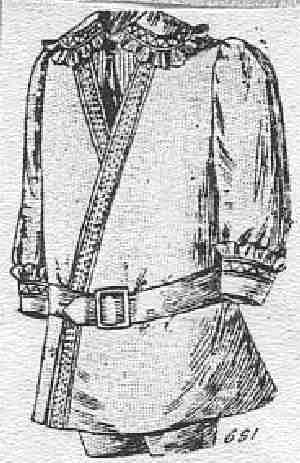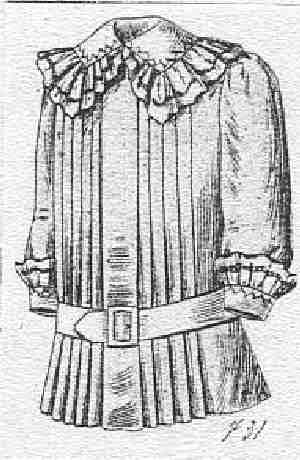
Figure 2.--Costume en drap mélangé gris moyen pour petit garçon de 3 à 6 ans: col et manchettes en linon: cravate en soie rouge. (Patron pour 3 et 5 ans: blouse no. 367: Fr 0.75. culotte no. 134: Fr 0.75.).


Figure 2.--Costume en drap mélangé gris moyen pour petit garçon de 3 à 6 ans: col et manchettes en linon: cravate en soie rouge. (Patron pour 3 et 5 ans: blouse no. 367: Fr 0.75. culotte no. 134: Fr 0.75.). |
The French fashion magazine, Moniteur de la mode in 1907 published a interesting articles about fancy suits for younger boys during the early 20th century. Moniteur de la mode was the most important French magazine. A French This text is very intrresting because it provides an is giving the analysis of the main elements concerning boys' fashions. Notice before 1900 the sailor suit originating in England was very influential and widely worn by a broad spectrum of French boys. Boys until about 5 years of age wore dresses like the girls, but a bit shorter. At the turn of 1900 the boys'french fashion changed. We call this period of the early 20th century (1900-13) before World War I, "La belle époque". These suits worn in the early 20th century were worn by boys that a decade earlier might have worn dresses."

Figure 3.--Robe à plis en toile de laine rouge pour petit garçon: col et manchettes en piqué avec volants de linon ourlés à jour. (Patron sur mesures pour 2 et 4 ans: Fr 1.50.) |
Presque tous les costumes des petits garçons de dix-huit mois à cinq ans ont des blouses plates, sans plis ou fronces; on les fait très courtes, de façon qu'elles s'arrétent au-dessus du genou, et c'est à peine si on aperçoit la petite culotte bouffante, serrée par un caoutchouc ou retenue dans un bracelet. De dix-huit mois à deux ans et demi, ces blouses-là ne conviennent guère qu'aux enfants minces et fluets; pour les autres, si vous ne voulez pas leur laisser les robes brillantées ou de Nansouk que mettent aussi les petites filles, adopter les robes à plis: la classique robe à plis égaux, droit fil, qu'assemblent seulement les coutures du dessous de bras et des épaules, la robe à plis évasés, plus nouvelles et façiles à réussir. Lorsque la robe ferme dans le dos, il est bien simple d'employer les collerettes rondes; ce sont des bandes droit fil de 95 centimétres à 1 m. 25 de longueur, suivant la taille des enfants; plusieurs rangs de fronces les retiennent à l'encolure; elles s'évasent dans le bas. Une guipure d'irlande basse et fine, une imitation de valenciennes à gros réseau souligné d'un entre-deux de méme dessin qu'encadrent souvent des groupes de plis minuscules, les rendent élégantes sans compliquer le lavage et le repassage, il est bon de les boutonner par deux brides, faites en dessous, de façon que les boutons soient cachés par le côté droit du col et n'accrochent point les cheveux qui les atteignent quelquefois. Si les blouses ferment au niveau du devant il faut, pour qu'elles soient vraiment pratiques, les boutonner jusqu'au bas; bien entendu cette fermeture est invisible, dissimulée sous un pli rond plus ou moins large semblable, par exemple, à celui du croquis 3: quatre plis couchés l'encadrent de chaque côté; on peut en faire trois
seulement à droite, et à gauche si l'enfant est trés petit. Les cols et les manchettes sont en linon souple, bordés d'un volant pareil qu'ajoure un entre-deux clair. Généralement l'ourlet est double ou triple, rapporté en surjet au bord de l'entre-deux.

Figure 6.--Costume en drap mélangé noisette pour petit garçon de 3 à 6 ans: col et manchettes en toile blanche bordés de plissés de linon. (Patron pour 3 et 5 ans: blouse no. 368: Fr 0.75; pantalon no. 294: Fr 0.75. |
HBC will attempt to translate this, but it is not an simple matter. Do let us know if you can suggest a better translation
Almost all the costumes of little boys from 18 months to 5 years have flat tunics , without pleats or creases; one makes them very short, so that they stop right above the knee, and one nearly can't
see the little puffed pants tightened by a rubber or retained in a bracelet. From 18 months to 2 years and half, those blouses are hardly appropriate except for thin children; for the others, if you
do not want to leave them in dresses of "brillantés" or of Nansouk which are also worn by small girls, adopt the pleated dresses: the traditional equal pleated dress, "straight thread", assembled
only by the seams of the dress shield and of the shoulders , the dress with flared pleating , newer and more easy to make succesfully.
When the dress closes in the back, it is quite simple to employ the round flanges; these are 'straight thread' stripes of 95 centimeters to 1 Mr. 25 length, according to the size of the children;
several rows of creases retain them at collar; they widen up at bottom. A low and fine irish point lace, an imitation of valencians with a large 'network' underlined by an 'in-between' of same drawing, frequently framed by groups of tiny folds, make them elegant without complicating washing and ironing, it is good to button them by two supports, made below, so that the buttons are hidden by the right side of the collar and don't touch the hair that reaches them sometimes. If blouses closes on front level, one should, so that they are really practical, button down to bottom; of course this closing is invisible, dissimulated under a more or less broad round fold similar, for example, to that of sketch 3: four lying folds frame it on each side; one can make three of them only on the right side, or on the left if the child is very small. Collars and cuffs are in supple
linon, bordered by a similar flounce 'trimmed' through a clear interval. Generally the hem is double or triple, brought back in overcasting at the edge of the interval .
A HBC reader has provided us an excellent English translation of the French text. It is a great improvement on HBC's initial primitive computer translation. We are most grateful for this tine consuming effort. Translations of these old texts are not an easy undertaking. He reports that there are some of these technical words where he can't
find actual English words. "Brillanté" is perhaps a type of cloth of some shining nature (brillant=diamond?). Perhaps a material like satin. "Droit-fil" literally means straight thread. "Réseau" translated initially to network, which is correct for rail or telecom usages. "Entre-deux" literally means "between both", which could be interval. "Ajourer" means with small holes that allow to see daylight, perhaps meaning to trim. Eyelet lace is another possibility. "Surjet" is a way to sew two pieces of cloth put one end over the other. Another reader tells that "le côté droit du col et n'accrochent point les cheveux" means "The boutunning are made with buttons and
loop and to avoid the hairs are tangling in; one proposes to made the buttonning inside."
The HBC catalog and advertising pages provide information about other styles of clothes worn by boys in 1907. The actual full page image of this article showing what the mothers of the boys wearing these suits wore is also posted on the 1907 page.
Navigate the Boys' Historical Clothing Web Site:
[Return to the Main French early 20th century chronology page]
[Return to the Main French Fauntleroy suit page]
[Introduction]
[Activities]
[Bibliographies]
[Biographies]
[Chronology]
[Clothing styles]
[Countries]
[Essay]
[Contributions]
[FAQs]
[Glossaries]
[Boys' Clothing Home]
Navigate the Boys' Historical Clothing French pages:
[Return to the Main French page]
[French choirs]
[French art]
[French catalogs]
[Difficult French images]
[French ethnics]
[French royalty]
[French sailor suits]
[French school uniforms]
[French school smocks]
[French scout uniforms]
